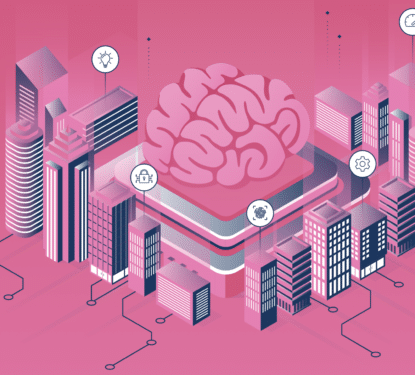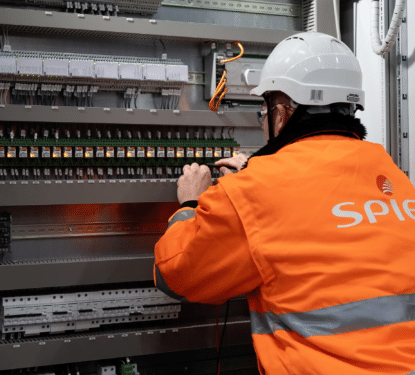We have been Imagining the “Pandemic-Smart” Buildings of the Future since the early stages of the global COVID-19 crisis. Adapting existing technology and placing greater emphasis on emerging technology that offers safety and infection-slowing applications to get people back into commercial buildings. Occupancy analytics for social distancing, fever-identifying thermal cameras, and an array of contactless or smartphone-based control interfaces can use the vast potential of the IoT to make our buildings “pandemic-smart.”
Smart building technology presents a compelling approach to support our safe “return to normality” until you realize that some of it is illegal under our prevailing data privacy laws, or at least it was before the crisis.
“The handling of such data is permitted only in certain cases. For example, if a higher, defendable interest justifies it and such handling is proportionate. On the other hand, employers must provide a working environment that does not threaten life and health. It is going to be a task for legislators to draw the line between the protection of privacy and public health; the consequences of the epidemic could prioritize the latter,” explain Dr. Attila Ungár and Dr. Kata Molnár, lawyers at Lakatos, Köves & Partners.
“In order to avoid a breach of data protection regulations, smart solutions should be used strictly in line with the relevant privacy rules and all of the data should be collected and processed only to the extent necessary to achieve the purpose of processing. Individuals should be notified of the data collection and, if possible, the collected data should be anonymized to reduce unnecessary personal data processing,” continue Ungár and Molnár in a Business Journal article. “Furthermore, protection against unauthorized use, proper storage, and documentation have never been more important.”
Consider building-integrated contact tracing technology, for example, which is now being rolled out in buildings across the US. Managed security services provider Kastle Systems has created an integrated, building-wide pandemic safety technology solution called KastleSafeSpaces, which enables office buildings to offer touchless access control, facilitate employee symptom screening, and manage contact tracing. As it is implementing at its Arlington office tower, also home to Nestle's US headquarters. Kastle has already announced a partnership with real estate investment firm Monday Properties to introduce the system in its DC metropolitan area portfolio.
Security providers are well-positioned to move into this new market but they are not alone. The first wave of building-integrated contact tracing solutions will come from those firms able to leverage the users, sensors, and data they already have. Real-time indoor location systems manufacturer Sewio usually provides tracking data for the retail, sport, entertainment, and livestock industries. However, they recently released RTLS for the workplace, sensor and portable transmitters enabled asset, fleet, and people tracking solution with contact tracing functionality.
In April, coworking space Knotel proposed a contact tracing app for members that would connect to its existing location tracking services. “It’s crossing a rubicon in terms of companies and personal privacy, but if your colleagues were on vacation in someplace and nobody knows about it and now they’re in the office, suddenly that became a really big thing,” Knotel founder Amol Sarva told The Real Deal.

Even residential buildings are considering contact tracing technology, leaving no personal data stone unturned in our mission to return-to-normality. “Smart home systems must now consider how that tracking could intersect with the way residents pair Google Home and Google Nest with their smart home devices. Says Scé Pike, founder and CEO of IOTAS wrote on Forbes. “A clear understanding of data ownership is imperative … When it comes to the data they input, and the data from all the devices they connect, who owns all that? This is a complicated issue with no easy answers.”
The reality is that the same kind of data these systems would collect in the name of pandemic-control presents incredible value beyond that purpose. Thermal camera data analytics has the potential to determine a person’s mood throughout the day, meaning their feelings towards specific people, tasks, news, or sales promotions. In addition to tracking our every move, this feels exactly like the road to a big brother dystopia that our data privacy laws are designed to avoid. The safety benefits are real, however. So, as health becomes the main public priority the question becomes, are we willing to risk the misuse of data for a quicker return to normality?
A June 2020 survey of 601 companies of varying size and industry by research firm WorldatWork found that 75% of employers plan to use contact tracing. Another survey, by workplace communications company Fishbowl, surveyed 17,000 professionals and found that 75% of employees are against the implementation of workplace contact tracing technology, and would not allow their employers to trace their activity. In combination, these surveys suggest a 99% chance of complications unless the health crisis swings one way or another —if the pandemic gets much worse there will be no stopping these solutions, but if things get much better it will be hard to overcome employee resistance.
70% of Americans are “deeply skeptical” about the contact tracing technology according to a Brookings Institute study, which also pointed out that for the system to be effective at least 60% of people would have to opt-in. The May study determined that the technology would face “enormous obstacles,” especially in the current political climate. “Skepticism toward digital contact tracing was not equal across racial groups, a disparity that if such apps are rolled out in the United States could result in further inequities in health outcomes among marginalized communities,” the Brookings study stated.
“We have serious doubts that voluntary, anonymous contact tracing through smartphone apps — as Apple, Google and faculty at a number of academic institutions all propose — can free Americans of the terrible choice between staying home or risking exposure,” technologist Ashkan Soltani, University of Washington professors Carl Bergstrom (biology) and Ryan Calo (law) wrote in an op-ed for the Brookings Institute. “We worry that contact tracing apps will serve as vehicles for abuse and disinformation, while providing a false sense of security to justify reopening local and national economies well before it is safe to do so.”
Whether it’s contact tracing, thermal cameras, occupancy tracking, or other technology, organizations have been given an unofficial emergency license to collect whatever data they want, in support of public health. It’s a great excuse to install more sensors, cameras, and apps because they can support an alternative to lockdown measures, and may even become vital to control a pandemic that is by no means under control. The data privacy debate has not changed but the world has, fuelling both sides of the argument during an evolving global disaster.



